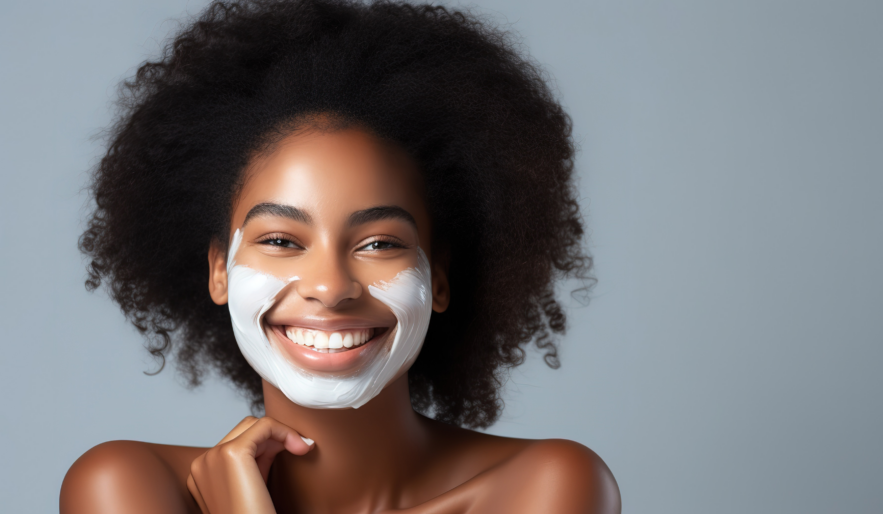Skin conditions can range from a mild annoyance, like an occasional blemish or patch of dry skin, to hives, rashes, and patches of scaly skin that itch or burn so intensely that you can’t focus on everyday activities. Some topical medications, like creams, require prescriptions from your healthcare provider, but many also fill the shelves of your local pharmacy or even grocery store, as well.
You may not even realize that when you’re reaching for an anti-itch cream to sooth your mosquito bite, you may be putting a drug on your skin, and possibly even into your bloodstream. Here’s what you need to know about the benefits and side effects of topical medications.
What are Topical Medications?
Topical medications are any sort of drugs that you apply to your skin, as opposed to swallowing or injecting into your body. They come in many forms such as gels, lotions, and creams. They can even be added to bathwater as a soaking element. Typically, you have an active ingredient, such as a corticosteroid, that is mixed with an inactive substance that makes it easy to apply to your skin.
Do Topical Medications Enter the Bloodstream?
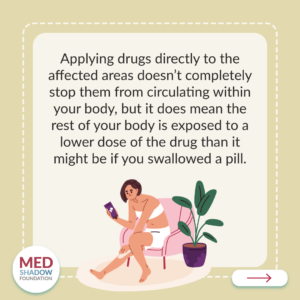
One of the main benefits of using a topical medication instead of a pill, syrup, or injection is that, if your ailment is on the skin or only on specific part of the body, (for example if you have pain, but only in your ankle), you can deliver the drug closer to that area instead of waiting for it travel through your digestive system and into your bloodstream. In many cases, this also means you’ll experience fewer side effects.
For example, while non-steroidal antiinflammatory drugs (NSAIDS) that come as gels or lotions may be more likely to irritate your skin, they are less likely to cause kidney problems, gastrointestinal, and cardiovascular side effects than pills you swallow that have to make their way from your mouth, to your kidneys or liver, all the way down to your ankle.
Still, even applying drugs directly to the affected areas doesn’t completely stop them from circulating within your body. Once absorbed, some of the drugs often do still end up in your bloodstream, meaning it’s still possible for topical medications to cause systemic side effects, such as stomach problems, in certain cases.
What is the Difference Between Medical Creams, Ointments, Gels and Lotions?
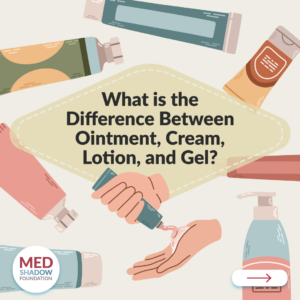
Topical medications come in many different consistencies and each preparation can deliver different concentrations of the active ingredient and offer separate benefits, such as cooling effects that can soothe itchiness. Of course, that means the consistency of the preparation may also impact the side effects it causes on your skin.
Ointments
Ointments are mostly made of oil. They can feel greasy but are also helpful for moisturizing dry skin or open wounds. They deliver more potent doses of drugs than creams or lotions.
Creams
Creams are made mostly of water with a little bit of oil mixed in. They dissolve quickly and usually deliver a little bit less of the active ingredient than ointments.
Lotions
Like creams, lotions are mostly water, but they contain even less oil than creams. They can soothe dry, itchy skin caused by dermatitis and fungal infections. They are easier to apply to most areas of your body than ointments and creams, including skin with hair on it.
Gels
Gels are made of only water, and do not contain any oil or fat. The skin absorbs less medication from gels than from ointments, creams, or lotions. They can be useful for conditions in which you want a low dose of medication that is absorbed slowly over time.
Foams
Foams are aerosolized solutions that usually use alcohol as a base. You quickly absorb medications from foams, and they can be applied to many areas of your skin including those covered in hair.
Soaks
If you add a soap, salt, crystal, or powder to your bathwater, you are creating a “soak.” You can’t easily control the exact amount of the drug you get, but you can efficiently apply it to large areas of your body. It’s mostly used for milder conditions that don’t require stronger medications.
Powders
Powders are dry and can be used on skin that’s been irritated by too much moisture or by skin-on-skin chafing.
Types of Skin Medications
Topical medications come in a variety of formulations that you rub into your skin or soak in.
Antibacterial
As you can likely predict, topical antibacterial medications are used to treat conditions caused by bacteria, such as certain types of acne, rosacea, staph infections, or wounds that could get infected.
Examples of Topical Antibacterial Medications include:
- Clindamycin
- Erythromycin
- Metronidazole
- Mupirocin
- Retapamulin
- Ozenoxacin
- Bacitracin
- Neomycin
Side Effects of Topical Antibacterial Drugs
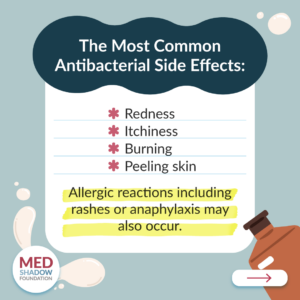
The most common side effects are
- Redness
- Itchiness
- Burning
- Peeling skin
- Allergic reactions including rashes or anaphylaxis
If your skin is slightly irritated—a little red or peeling more than usual—it’s important to keep it moisturized. In addition to your normal moisturizer, you may find that applying aloe vera is soothing, Anna Chacon, MD told MedShadow. Chacon is a dermatologist with MyPsoriasisTeam, an online support group for those with psoriasis.
Topical Steroids
One of the most common types of over-the-counter (OTC) topical medications is cortisone. It treats itchiness caused by mosquito bites, rashes, and mild burns. It’s a corticosteroid, which works by reducing inflammation. These types of drugs are common in prescription medications for eczema, psoriasis, and other inflammatory skin conditions.
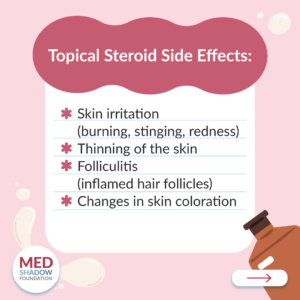
“Topical steroids, while effective, have many side effects, especially when used long term,” dermatologist Emma Guttman, MD, Ph.D., told MedShadow. Guttman is vice chair for research in the department of dermatology at the Icahn School of Medicine at Mount Sinai in New York City.
Side Effects of Topical Corticosteroids
- Skin irritation (burning, stinging, redness)
- Thinning of the skin
- Folliculitis (inflamed hair follicles)
- Changes in skin coloration
In some cases, if you use high doses of topical corticosteroids, or take them consistently for an extended period of time, (the timing and dose will likely vary from person to person) you may end up with more of the drug in your blood stream leading to systemic side effects, more like the ones you might experience when taking oral corticosteroids, such as:
- Increased appetite
- Stomach upset
- Acid reflux
- Swelling (especially in the legs and face)
- Mood changes
Topical Anti-inflammatories
In addition to corticosteroids, there are other drugs that target inflammation through your skin. They’re typically used to treat psoriasis and eczema. However, there are also topical non-steroidal anti-inflammatory drugs for pain, as well.
Topical Anti-inflammatories include:
- Eucrisa
- Diclofenac (NSAID for pain)
- Elidel
- Protopic
Side Effects of Topical Anti-inflammatories
Labels on Elidel and Protopic include a black box warning due to the potential risk of cancer (about 1% of people who used the Elidel developed lymphoma and skin cancer) with long term use. Researchers found a weak association between the drugs and a heightened risk of lymphoma, but not other cancers, in a more recent 2021 study.
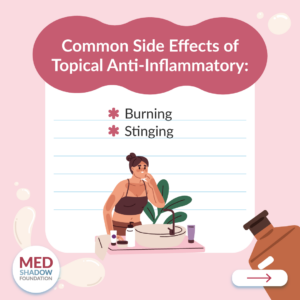
As a result, these treatments are only recommended for people who can’t use other treatments, or whose eczema symptoms did not improve with other treatments.
Protopic’s black box includes a warning not to use the stronger 1% formulation in children between 2 and 15 years old. Only the .03% strength should be used by this age group. Also, neither Elidel nor Protopic is recommended for use longer than six weeks.
Common side effects of topical anti-inflammatories include:
- Burning
- Stinging
Topical Antifungals
Fungal infections are common on your skin, nails, and scalp. For these types of infections, there are a variety of topical powders, gels, and creams to treat the conditions. Antifungals work by killing fungus or stopping it from replicating and spreading.
For some types of fungal skin and nail infections, you may be able to purchase an OTC antifungal cream, ointment, or vaginal tablets. Still, it’s best to speak with your healthcare provider before taking an OTC antifungal if you can, because bacterial infections can cause similar symptoms.
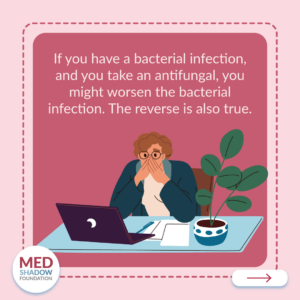
If you have a bacterial infection, and you take an antifungal, you might worsen the bacterial infection. Antifungal medications only kill fungus; for bacteria, you need an antibiotic. If the infection is more severe, you may need a prescription antifungal.
Examples of antifungals include:
- Mycostatin
- Monistat (miconazole)
- Diflucan
Side Effects of Antifungals
- Increased risk of bacterial infections
- Itchy, red skin
There are many types of antifungals, and each comes with its own side effects. Read Get Rid of Fungal Infections: Antifungal Treatment Options and Side Effects.
Topical Chemotherapy
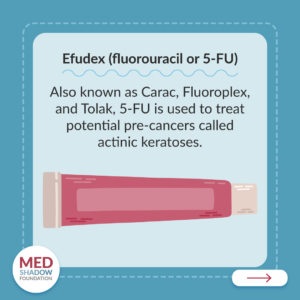
Efudex (fluorouracil or 5-FU), also known as Carac, Fluoroplex, and Tolak, is used to treat potential pre-cancers called actinic keratoses, which are crusty, scaly growths caused by damage from sun exposure. Efudex works by preventing the production of DNA in the cell being treated, resulting in the death of the cell. It is generally used twice a day for four weeks.
When April Pulliam first treated her chest with the chemotherapy cream Efudex, the itching, burning, and seeping sores were to be expected, as the cream irritated potentially precancerous spots. The nausea, nagging headaches, and fatigue, however, were not.
“I was surprised that a cream could make me feel tired and run-down,” the third-grade teacher from Bolivar, Tennessee, said.
Then she realized that it made sense.
“It’s chemotherapy in a cream,” she told MedShadow.
Several other patients shared her experience on AskAPatient.com, where they described extreme fatigue and flu-like symptoms while using the treatment.
Side Effects of Efudex Include
- Redness
- Irritation
- Sores and blisters
But other possible side effects of Efudex include:
- Trouble sleeping
- Irritability
- Temporary hair loss
- Abnormal taste in the mouth.
- Stomach or abdominal pain
- Bloody diarrhea
- Vomiting
- Signs of infection (fever, chills, persistent sore throat)
- Easy bruising or bleeding or mouth sores.
Keratolytics
Keratolytics are drugs that accelerate the exfoliation of your skin, helping older skin cells flake off. These drugs are often used to treat acne, signs of aging, psoriasis, warts, and calluses. Examples of keratolytics include:
- Salicylic acid
- Retin-A (tretinoin)
- Urea
Side Effects of Keratolytics
Since these medications work by helping your outer layers of skin flake off, peeling skin is a common side effect. They are also known to cause:
- Redness
- Itching
- Stinging and burning
- Increased risk of sunburn
Antihistamines
You may be familiar with antihistamines, which are available OTC as pills to treat seasonal allergies. However, antihistamine gels and creams can treat allergic reactions on the skin such as hives, or mosquito bites.
Examples of topical antihistamines include:
- Benadryl cream (diphenhydramine/zinc acetate)
- Prudoxin (doxepin cream)
Side Effects of Topical Antihistamines
- Allergic reactions on the skin (experts recommend taking oral diphenhydramine as opposed to creams, which are more likely to cause allergic reactions that worsen your symptoms)
- Burning or stinging
- Drowsiness (occurs in 20% of patients who use Prudoxin, especially if you apply it to more than 10% of your skin.)
- Dry mouth
- Hives
- Dizziness
- Mood changes
Natural Topical Remedies
When your skin starts to get a little red and angry or your muscles get a bit achy there are options you can try before reaching for the cortisone cream.
Cool Your Skin with Oatmeal Baths
Oatmeal mixed with water can help to cool rashes brought on by heat.
Studies have shown that such mixtures can also aid in relieving irritated skin conditions, due to oatmeal’s antiinflammatory properties. While some products (such as Aveeno) contain oatmeal, the food itself can be used to increase skin’s moisture on its own.
One 2018 review explained that the antioxidant and antiinflammatory effects of colloidal oatmeal are derived from a plant chemical called “avenanthramides.” Some say oatmeal may also soothe the skin after a sunburn.
For preparation, some recommend a cup of steel-cut, organic oatmeal mixed with warm water. Mix the oats in a bowl until a paste is created, and apply it to the skin. Allow the paste to dry before removing with warm water.
Ease Pain with Epsom Salt Soaks
Studies show that salts, like Epsom, break down in water. In this process, magnesium and sulfate are released. Studies show that magnesium has benefits treating everything from depression to body aches. However, there has been limited research if the element is absorbed through the skin during treatment such as a bath.
How Do You Fix Sensitive Skin?
Seventy percent of adults say they have sensitive skin, according to a 2019 study. Erum Ilyas, MD, a dermatologist at Schweiger Dermatology, explains that sensitive skin is not a medical condition in and of itself. The self-diagnosed condition can mean different things to different people.
“Usually when people say they have sensitive skin, they are implying that their skin gets irritated really easily,” he says.
Your skin can get irritated for a variety of reasons, from dryness to allergies, rosacea, and even because of products, such as retinol or vitamin C, designed to irritate it with the goal of creating a youthful appearance.
One way to manage sensitive skin is to look at the products you’re using and consider whether some of them contain active ingredients that you should use less often, or that you should only use at night because they make your skin more sensitive to the sun. You can also visit a dermatologist to determine if you have conditions like rosacea, or precancerous spots called actinic keratosis, that may be irritated.
Drugs that Can Affect Your Skin or Make it More Sensitive to the Sun
It’s not just topical creams and lotions that affect your skin. Many drugs can cause side effects that dry out or irritate your skin, including:
Other drugs can make your skin more sensitive to the sun. Make sure to protect your skin when you go outside if you’re using any of the following medications:
- Antiarrhythmics such as amiodarone (Cordarone, Pacerone, Nexterone)
- Antipsychotics such as chlorpromazine (Thorazine, Largactil)
- Many types of antibiotics such as doxycycline (Adoxa, Vibramycin, Doryx, Monodox, Oracea, Periostat) Nalidixic acid (NegGram), tetracycline (Sumycin), sulfonamides, ciprofloxacin, and trimethoprim.
- Diuretics such as hydrochlorothiazide (Microzide), which is used to treat high blood pressure
- Chemotherapy and immunosuppressant drugs such as methotrexate, which treats cancer and some autoimmune diseases
- Nonsteroidal anti-inflammatory drugs (NSAIDS), such as Midol and Aleve
- Statins, such as atorvastatin, lovastatin, pravastatin and simvastatin, used to lower cholesterol
- St. John’s wort, (hypericum perforatum), used to treat depression and menopause
- Antifungal medications such as voriconazole (Vfend),
- Antihistamines that treat allergies
- Oral contraceptives
- Retinoids such as tretinoin
- Sulfonylureas for type 2 diabetes (glipizide, glyburide)
What is the Healthiest Sunscreen to Use?
As you now are undoubtedly aware, creams, gels, and sprays that you rub on your skin can be readily absorbed into your bloodstream. That includes sunscreens. The best way to reduce your risk is to use clothing and hats to protect your skin when you’re in the sun, and then apply sunscreen only to the portions of your skin that you can’t otherwise cover.
Nonetheless, that advice isn’t always practical for sports, swimming, and other outdoor activities on hot, sunny days. When you do need to use sunscreen, reach for formulas that use minerals, zinc oxide, or titanium dioxide to block the sun with a physical barrier, as opposed to other products that cause a chemical reaction.
The latter are more readily absorbed into your skin, and the safety of many of these chemicals is still unknown. Some are endocrine disruptors which interfere with the functioning of the glands and organs in our bodies that release hormones responsible for guiding our growth, development, metabolism, reproduction, and more.


